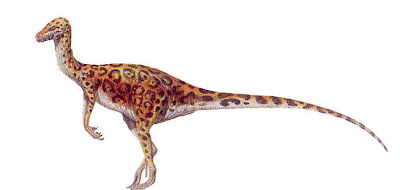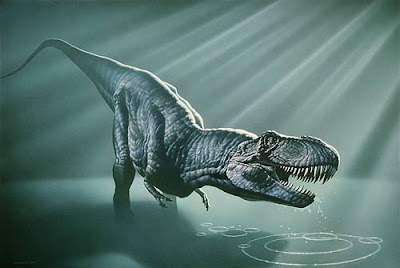
The name says it all. This group of huge carnivores must have tyrannically ruled the land during the last part of the Cretaceous, 85 to 65 million years ago. Short but deep jaws with banana-sized sharp teeth, long hind limbs, small beady eyes, and tiny forelimbs (arms) typify a tyrannosaur. The Tyrannosauridae included such similar animals (in rough order of increasing size) as Albertosaurus, Gorgosaurus, Daspletosaurus, Tarbosaurus, and of course Tyrannosaurus rex. A tremendous skeleton of Tyrannosaurus now stands guard in the Valley Life Sciences Building, which houses the UCMP and the Department of Integrative Biology at UC Berkeley. Tyrannosaurs belong to the Saurischia, or "reptile-hipped" dinosaurs. Within the Saurischia, tyrannosaurids belong to the group of carnivorous dinosaurs known as theropods.
Traditionally, the tyrannosaurs have been included within the Carnosaura. In this classification scheme, carnosaurs represent the largest carnivorous animals to ever walk the land. However, recent work has shown that tyrannosaurs are in fact a highly derived group of coelurosaurs, which is mostly composed of smaller animals (including the smallest of all non-avian dinosaurs, the crow-sized Compsognathus, and also the birds). Tarbosaurus had a good sense of smell and had binocular vision, two characteristics that would have made it an excellent hunter.
How Did Tyrannosaurs Move? Since tyrannosaurs were so huge, you might ask how they could move well and hunt prey? Many scientists familiar with the principles of biomechanics (physics applied to living organisms) think that tyrannosaurs could move fairly fast, maybe 10-20 mph, but not as fast as the smaller theropod dinosaurs.
Smaller tyrannosaurs like Albertosaurus or young individuals may have moved faster than the bigger ones like T. rex. Yet we still lack any clear evidence that tyrannosaurs could even run; some think that their body size limited them to only a fast walk, like an elephant. Trackways that unambiguously were made by tyrannosaurs would clarify the matter, but so far these are not known, apart from one probable footprint.

Tyrannosaur Fossils
Tyrannosaurs are surprisingly common in many North American fossil beds, especially their large, serrated teeth, which they shed periodically like most archosaurs. The teeth of tyrannosaurids are very interesting — rather than being the flat knifelike blades as in most other carnivorous dinosaurs, they are, as Berkeley's Professor Kevin Padian describes them, "like lethal bananas;" more like giant spikes than razor-edged blades. With a mouthful of this murderous fruitlike dentition, tyrannosaurs had a whopping bite, which might have made up for their reduced forelimbs.
The bite marks of these teeth are quite recognizable on some dinosaur bones. Some tyrannosaur fossils show evidence of bite marks from other tyrannosaurids, suggesting that there might have been fierce fighting between tyrannosaurs, or even cannibalism.























